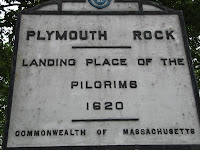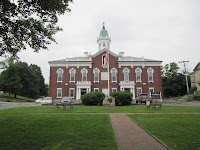

The Rock area of the town is a typically quaint looking New England village, with beautiful waterfront, some really nice houses, and lots of little shops with fudge, taffy and t-shirts to spend your money on.




We stopped first at the Mayflower II, a replica of the original Mayflower that the Pilgrims sailed on. We were quite surprised to see just how small it was...110 feet in length, and squeezed onto it were 102 passengers, about 30 crew members, and some livestock like chickens, goats and sheep. They left England in September 1620, arrived in Plymouth in December of 1620, and stayed on the ship while they prepared the settlement till they finally got off for good in March 1621. That's 6 months if you are counting!!!


Most of what you read and hear is that the Pilgrims sailed for 65 days before reaching the new world, but when they say that they mean their original stopping point of Provincetown at the tip of the Cape. There was no fresh water there and it was a pretty inhospitable spot, so they continued on to the harbor at Plymouth and found it to be a much better settlement spot. Because of the harbor and what is called Cole's Hill, this was an area that would be easier to defend from attack if they had to defend it than a lot of other places, and there was also fresh water here.

The "Rock"! Once 3 to 4 times its current size, it has broken both horizontally and vertically, in addition to having people chisel away at it for souvenirs. Now it is at the base of this structure, subject to the tides. Another interesting tidbit: at least if you come from this area, we all grew up learning that Plymouth and Massachusetts were the places of the 1st settlers to the New World. What they didn't tell us is that what they meant to say was the 1st successful English settlement!!! If you go to St Augustine, FL, or Roanoke and Jamestown, VA they may have a quarrel with the claims we make to "1st" of anything...haha!!



This is Cole's Hill, directly across the street from the Rock and overlooking the harbor. That's me down at the Rock, waving.


A famous American Indian, this statue is one of a few up on Cole's Hill. Another reason this area was perfect for the Pilgrims to settle was the fact that the local Indians were agricultural tribes, so a lot of the land was already cleared. In addition to that, over a period of a few years prior to the Pilgrims landing, approximately 90% of the natives all the way from Maine to south of Massachusetts had died from diseases brought by other settlers to the region. That meant they didn't have much resistance to their taking over this land.


Right next to the Indian statue is this plaque talking about current day Indians and how they view "Thanksgiving". Need less to say, they are not amused! Blow it up to read it...interesting.

This tomb is also up on Cole's Hill, and contains the remains of the 51 Pilgrims who died during the 1st winter here. They died from either disease or starvation.

Commemorating the 1st house built in 1621, on this, the 1st street.


Site of one of the original 7 houses built in the 1st year of the settlement...I guess everyone else was in huts?


These 2 churches are prominently built at the top of a hill, one beside and facing the other, but literally almost on top of each other. They have been involved in a bit of a tiff since 1802, when the original congregation of the 1st Parish Church (with the tree in front) were led by a new preacher who introduced not just the concept of the trinity (father, son and holy ghost), but the primacy of this concept to their religion. This 1st church is the oldest continually active congregation in the country. After the congregation took a vote that went 52% to 48% in favor of the trinity concept, the 52% became what is known today as Unitarian Universalists (UUs) and kept the church building, while the 2nd group became Congregationalists and built their new church, the white one, right next door. Notice how many signs the UUs have pointing out that they were here 1st. You could tell this stuck in the craw of the lady giving us the tour of the white church--haha.






Because they don't have much to crow about, I will give the Congregationalists 2 views on the page.


This court house was built in 1749 and is the oldest wooden court house in the country.

The National Monument to the Forefathers was out in the middle of a neighborhood, quite separate and seemingly forgotten by the tourism promoters. We picked up a pamphlet stapled together as an afterthought by someone in the Visitor's Center, and stopped to see it on our way of town.


It is actually quite impressive, on a large plot of land, it is 81 ft tall and the largest granite structure in the US.

Because it's so detailed, it took 29 years to build, starting in 1859/finishing in 1888. The main pedestal holds the pamphlet calls "the historic figure of Faith".

And it's surrounded by what are meant to be the core principles upon which the Pilgrims founded the Commonwealth; Liberty, Education, Law and Morality.




These shots may give you an idea of just how tall it is. Notice me at the base of the structure in the 2nd pic.



So, that makes it a wrap for the day! Marie came down with Emily on Sunday, and then we were joined by Kaleigh and Jack on Monday, so that blog will follow shortly.
That courthouse looks like brick, not wood. (I don't get it). Is it used as a courthouse? I ask because in my county, we have the oldest courthouse in NY (1772), and one of the oldest in the country that is still in use as a courthouse. (Maybe a little side trip when you go to NY?)
ReplyDeleteThis looks like it was a good trip. I'm not sure I get the whole rock thing either? The boat is cool, maybe they just slept there while they were building the settlement, it would suck to actually have had to stay on there all that time.
Very interesting!!!! I remember going there with school when we where young!
ReplyDeleteAlso, I have always thought the Jamestown, VA was the first settlement, what school did you go to that said Plymouth???? lol
I think it looks like brick also Barb, but I only took the picture from the street and didn't go up to touch it...maybe wood underneath the brick??? haha
ReplyDeleteThe guide told us that the men got off the Mayflower during the day to prepare the settlement and then went back in the evening, but that the women and children stayed on the ship the whole time...must have been unbearable, if you ask me.
I have to question what I was taught also Ellen...haven't you always thought the Pilgrims settled the New World, that the Pilgrims landed in Plymouth, and therefore the 1st place in the country to be settled was Massachusetts? I must have missed something in the translation...I am curious as to what everyone else was taught/thinking? And what about St Augustine, FL? They claim to be 1st at something too...I would have to research it...NOT!!! haha
ReplyDeleteThe first settlement in Massachusetts, not in the New World???????????
ReplyDeleteI am so glad I did not have the same nuns as you, lol
I was from Va. and Jamestown was the first settlers. I guess it doesn't matter someone had to be the first settlers. You know History books teach you what they think that State is famous for. We were suprised at the rock. I was thinking of a boulder not a rock but I think age is not its friend.
ReplyDeleteI don't think it was even the 1st settlement in Massachusetts, Ellen...the guide emphasized the 1st "Successful", "English" settlement!!! I was hoodwinked!!! haha
ReplyDeleteLike the lake just because you said it was warm and not real cool.
ReplyDeleteOh, did you get your RV fixted????
ReplyDeleteWe take the RV in on Tuesday...keep your fingers crossed for us!
ReplyDelete